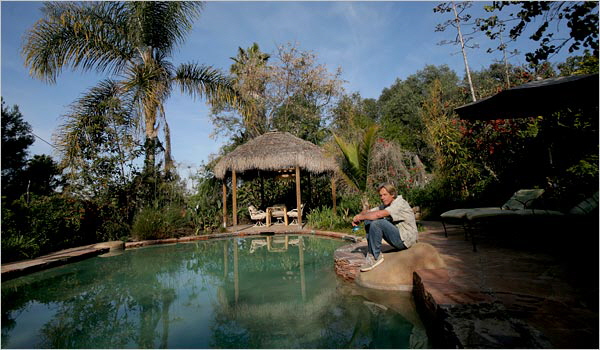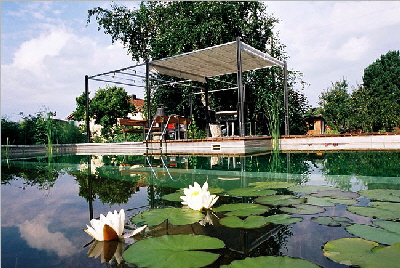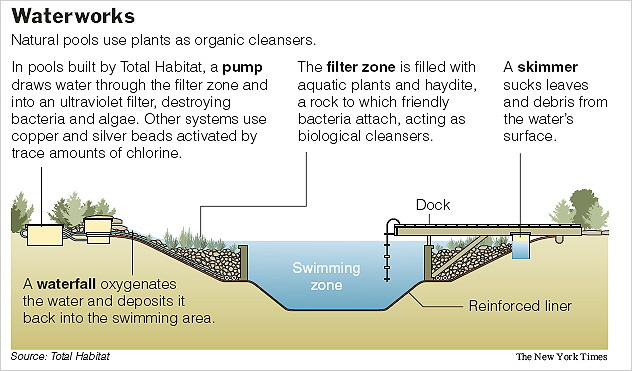![]() April 5, 2007
April 5, 2007
From Europe, a No-Chlorine Backyard Pool
MICK HILLEARY, an industrial designer who builds zoo exhibits and trade show displays, and who expanded into residential pools five years ago, has found that Americans have a clearly defined idea of what constitutes a proper swimming pool. “It’s a white-tiled thing,” said Mr. Hilleary, whose company, Total Habitat, in Bonner Springs, Kan., specializes in what could be called the opposite of the white- or blue-tiled things found in millions of backyards across the country.
The “natural pools” that Total Habitat builds are bordered with wood, planted with lush vegetation and free of chemicals like chlorine; they resemble nothing so much as a swimming hole. “It’s natural-looking, like a pond,” Mr. Hilleary said. “But the water looks so clean. People really want to swim in it, more than in a farm pond.”
Natural swimming pools (or swimming ponds, as they are called in Europe, where the concept originated 20 years ago) are self-cleaning pools that combine swimming areas and water gardens. Materials and designs vary — the pools can be lined with rubber or reinforced polyethylene, as in the case of Total Habitat’s, and may look rustic or modern — but all natural pools rely on “regeneration” zones, areas given over to aquatic plants that act as organic cleansers.
 The pools have skimmers and pumps that circulate the water through the regeneration zone and draw it across a wall of rocks, loose gravel or tiles, to which friendly bacteria attach, serving as an additional biological filter. Unlike artificial ponds, which tend to be as murky with groundwater runoff and sediment from soil erosion as the natural ponds they’re modeled on, in a natural pool the water is clear enough to see through to the bottom.
The pools have skimmers and pumps that circulate the water through the regeneration zone and draw it across a wall of rocks, loose gravel or tiles, to which friendly bacteria attach, serving as an additional biological filter. Unlike artificial ponds, which tend to be as murky with groundwater runoff and sediment from soil erosion as the natural ponds they’re modeled on, in a natural pool the water is clear enough to see through to the bottom.
The pools, which cost about the same as or slightly more than conventional ones, depending on landscaping, appeal to gardeners because of the great variety of plant life that can be grown in them, as well as to green advocates and others who don’t want to swim in chlorinated water.
“Many, many people don’t like chlorine,” said Bryan Morse, who runs a landscaping company in Vista, Calif., called Expanding Horizons that builds water features and branched into natural pools five years ago. Taking advantage of the Southern California climate, Mr. Morse created a sort of jungle lagoon in his own backyard, building a natural swimming pool with a thatch-roof palapa and a regeneration zone filled with tropical foliage like Madagascar palm and varieties of canna lilies.
The business is hardly a growth industry, at least in the United States. Total Habitat has built eight natural pools, mostly in the Midwest. (Mr. Hilleary said he has formed a trade organization, the Natural Swimming Pool Association, “to protect the integrity” of the industry; he has certified himself under its requirements. The group has only two members, Mr. Hilleary and Michael Littlewood, a builder in England.) Mr. Morse said he has built four pools, including his own, mostly for “ex-hippies.”
The pools are more popular in Austria, where a company called Biotop has been designing them for residential and public use since 1986 and now installs about 50 a year, according to Peter Petrich, Biotop’s owner and the person credited with inventing the concept.
 Mr. Petrich said he and his colleagues have given much consideration to why natural pools haven’t caught on in the United States and have concluded that “perhaps in Europe people have more contact with nature and life is not so clinical.”
Mr. Petrich said he and his colleagues have given much consideration to why natural pools haven’t caught on in the United States and have concluded that “perhaps in Europe people have more contact with nature and life is not so clinical.”
Toni Schneeweiss of Biotop said that private pools in Austria, unlike those in the United States, generally do not require building permits, which can be harder to obtain for projects using unfamiliar technology. But it is also true that natural pools are not well known in the United States, and that it is hard to find people to build them.
For builders like Mr. Hilleary and Mr. Morse, natural pools are a side business, and mainstream pool contractors don’t seem to offer them at all. Penny Johnson, the chairwoman of the Association of Pool & Spa Professionals, an industry trade group, said she had never heard of the concept until she was asked about it for this article. She expressed skepticism about the technology. “I don’t know how plants could filter the water for bathing use,” she said, adding that in her experience outdoor pools have to be “shocked” with chemicals to kill bacteria.
Asked about safety concerns, Mr. Petrich said that the water in the natural pools his company builds meets European Union standards for bacteria levels and that the risk of swimmers becoming sick is “very low.”
One American homeowner who has such a pool, Jim Smith, a 45-year-old computer programmer who lives in a suburb of Wichita, Kan., said he learned about the pools in a sales pitch given by Mr. Hilleary at a home show in 2002. Mr. Smith and his wife, Susie, who is an avid gardener, decided to build a natural pool with a miniature waterfall, plants like hornwort and anacharis and a 40-foot recirculating stream that would run past their living room windows. (Mr. Smith said he spent about $50,000 on the pool, or $20,000 more than he estimates a standard pool would have cost; he attributed the higher cost in part to elaborate landscaping.)
 WATERWORKS
WATERWORKS
The couple, who have two daughters, had a chlorinated pool at a previous home, and Mr. Smith said the transition was difficult. “It took us the first year to learn how to deal with the water,” he said, referring to the way natural pools can become overgrown with algae. “In a regular pool, you just put chlorine in and shock it.”
Indeed, algae is the great scourge of the natural pool world, for aesthetic reasons more than anything else. “It’s very important for people that their water be clear,” said Mr. Petrich, whose pools in Europe use plants to starve algae of nutrients.
Algae tends to be a problem in the first year of a pool’s existence and then to clear up significantly once the plants have grown large and developed a root system, he said. (Each spring, natural pools will go through an algae phase anyway, Mr. Morse said.) But given algae’s sliminess and the widespread view of it as disgusting, Mr. Hilleary has taken additional measures to stem the growth of algae and eliminate bacteria, installing ultraviolet sterilizers in the pump area.
Mr. Morse said he adds trace amounts of chlorine — less than the amount found in tap water — which reacts with silver and copper beads housed in the pump area and has a similar effect.
Still, owners say that once they adjust to the idea of their pools as living ecosystems and master the maintenance particular to natural pools — trimming dead plants; fishing debris and the occasional snake or turtle out of the water — there are advantages. Watching the seasons change is one. “In the spring, all the wildflowers come up,” Mr. Smith said, both in and near the water. “In December, the pool ices over and becomes gorgeous.” Two ducks spent the last month visiting the Smiths’ pool.
There are also the elaborate landscaping and design possibilities. The regeneration zone can be along the perimeter of a natural pool or on one side of it, separate from the swimming area, and, as Mr. Hilleary says, “a person can go to town with water plants,” like marsh marigolds and water lilies.
Bill Johnson, a petroleum engineer in Wichita, built a natural pool at his family’s house last summer with two waterfalls and a bordering wall built of massive boulders — a design that would have been difficult with a conventional pool, he said, because the concrete liner might have buckled under the weight. “With the natural pool I don’t mind if the ground shifts a little,” Mr. Johnson said. “It gave us flexibility with the landscape.”
Mr. Littlewood, a landscape designer in England who has built 35 natural pools in southern England since 2001 and wrote a book on the subject, “Natural Swimming Pools,” said a natural pool blends into its surroundings in a way that a “turquoise box” cannot. “It’s beautiful to look at all year round,” he said, “and you can educate your children about the ecology.”
S ome owners of conventional pools have also begun turning toward more organic-looking styles, said Gina Samarotto, a designer at All American Custom Pools and Spas in Norwalk, Conn., who has noticed an increased demand for landscape features like boulders and native plants around pools. She added that she has also seen an increase in the popularity of copper-silver ionization systems that significantly reduce chlorine content.
ome owners of conventional pools have also begun turning toward more organic-looking styles, said Gina Samarotto, a designer at All American Custom Pools and Spas in Norwalk, Conn., who has noticed an increased demand for landscape features like boulders and native plants around pools. She added that she has also seen an increase in the popularity of copper-silver ionization systems that significantly reduce chlorine content.
Whether Americans will go for the natural pool remains to be seen. For those who do install them, Mr. Smith offered some advice born of experience. “I wouldn’t say they’re for everyone,” he said. “You can’t be uptight and unable to wait on nature to repair things.”
Algae, he said, “is natural, and healthy water is going to have some algae.”
One more tip: “Kids like to throw algae.”
Call: (760) 505-7900 Email: bryan@expandinghorizons.biz
© 2018 Expanding Horizons is a part of the Omni Pragma® family All rights reserved.

